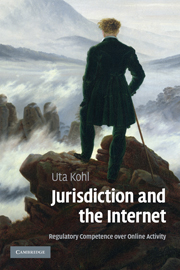Book contents
- Frontmatter
- Contents
- Preface and acknowledgments
- Table of cases
- Table of statutes, regulations, directives and treaties
- 1 Jurisdiction and the Internet
- 2 Law: too lethargic for the online era?
- 3 The tipping point in law
- 4 Many destinations but no map
- 5 The solution: only the country of origin?
- 6 The lack of enforcement power: a curse or a blessing?
- 7 A ‘simple’ choice: more global law or a less global Internet
- Bibliography
- Index
2 - Law: too lethargic for the online era?
Published online by Cambridge University Press: 18 July 2009
- Frontmatter
- Contents
- Preface and acknowledgments
- Table of cases
- Table of statutes, regulations, directives and treaties
- 1 Jurisdiction and the Internet
- 2 Law: too lethargic for the online era?
- 3 The tipping point in law
- 4 Many destinations but no map
- 5 The solution: only the country of origin?
- 6 The lack of enforcement power: a curse or a blessing?
- 7 A ‘simple’ choice: more global law or a less global Internet
- Bibliography
- Index
Summary
National trademarks versus international domain names
The clash between national law and the transnational online world starts with the most basic aspect of the Internet, namely, its address system, the domain name. Johnson and Post in ‘Law and Borders – The Rise of Law in Cyberspace’ used the conflict of trademarks with domain names (as well as other marks on websites) as the archetypal example to argue for a paradigm shift away from laws based on geographic boundaries, that is, traditional national laws. Their initial statement of the problem captures its essence perfectly and has been echoed innumerable times.
Consider the placement of a ‘traditional’ trademark on the face of a World Wide Web page. This page can be accessed instantly from any location connected to the Net. It is not clear that any given country's trademark authorities possess, or should possess, jurisdiction over such placements … Large US companies may be upset by the appearance on the Web of names and symbols that overlap with their valid US-registered trademarks. But these names and symbols could also be validly registered by another Party in Mexico whose ‘infringing’ marks are now, suddenly, accessible from within the United States.
Since then, a decade has passed, confirming the accuracy of this description again and again. Not only has intentional trademark abuse flourished on the Internet, but there have been countless disputes with one legitimate trademark owner, inadvertently through his online activities, encroaching onto the territorial sphere of another equally legitimate trademark owner.
- Type
- Chapter
- Information
- Jurisdiction and the InternetRegulatory Competence over Online Activity, pp. 33 - 65Publisher: Cambridge University PressPrint publication year: 2007

